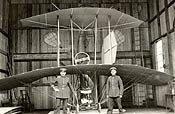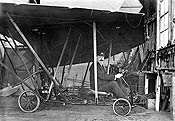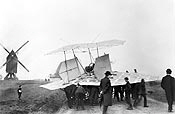First powered flight in the history of aviation
Why the Hanoverian aviation pioneer finally needs to be acknowledged
On the threshold to the 20th century many pioneers the world over, some more talented than others, began to contemplate the idea of powered flight. For example in the USA, Denmark, Great Britain and Russia, but also in Germany (see page ”The Evidence” in the article ”Beating the Big Drum” published in the Magazine AERO International”).
It was due to the constant assertions and jubilations, especially on the other side of the Atlantic,about there having been no other powered flight before the Wright brothers, that the working group concerned with the history of industry and technology in the Hanover region got together with the Haus & Grund Trust and Hanover Airport to organise
The Jatho Project. Their aim is to reconstruct the Hanoverian Karl Jatho’s flying machine and let it fly again.
According to careful research and verified documents there is
no denying the following achievements of the pioneer:
It is said that Orville Wright was the first to fly a powered craft on December 17
th, 1903 over the sand dunes of Kitty Hawk. Whereas the Wright brothers used a catapult to take off and exploited the updraught from the incline,
Karl-Jatho took off from flat ground with the exclusive impetus of his engine. That was on August 18
th, 1903,
4 months to the day
before Orville Wright.
|
|
Though Jatho managed a mere 18 metres on his very first flight, with a tricraft, barely one metre above the ground, by November 1903, still one month before Wright, he accomplished a series of flights over 60 metres and more than 3 metres above the ground.
Jatho had changed from a tri-craft to a bi-craft, as he called his con- struction. And it is this ”double-decker” – undoubtedly successful before the American competitors – that awaits its rebirth in a hanger at the airport Fürstenwalde.
|
|
|
The Hanoverian Karl-Jatho, unlike the Wright brothers, attached great importance to a seat for the pilot in his constructions. He thought having to operate the complicated steering elements from a lying down position was too problematic.
|
|
|
Jatho realised, long before anyone in the USA thought it important, the necessity of a runway for powered flights. As such he can be regarded as the initiator of the world’s first airport.
|
|
|
Following Jatho’s suggestion, the building of the first runway for aircraft, near the Lister Mühle (mill) on the Vahrenwalder Heide, Hanover, was approved on July 31st, 1907. Up until then the industrious pioneer had paid for the extension of his originally 180 metre long runway to a length of 300 metres, 2.5 metres wide, out of his own pocket.
|
|
|
|

|
|
|
Jatho’s Zweiflächler wird von Soldaten bewacht
|
|
|

|
|
|
Karl Jatho sitzend am Steuer, wie heutige Piloten
|
|
|

|
|
|
Der Zweiflächler vor dem Start
auf der Vahrenwalder Heide
|
|
Wolfgang Leonhardt, whose uncle had once worked as an engineer on some of Jatho’s later constructions, wrote a detailed factual biography to honour the Hanovarian flight pioneer, entitled ”Karl Jatho’s first powered flight 1903”. (ISBN 3-8311-3499-5)
Gunter Hartung
Top
© 2006 - 2018 Design by PHOENIX Advertising, Service & Communication · www.phoenix-werbeagentur.com



